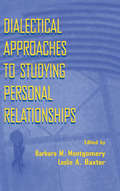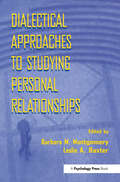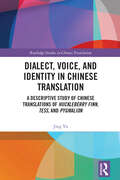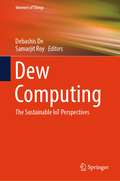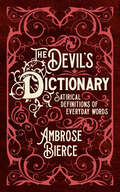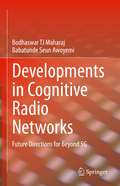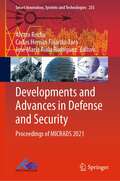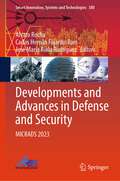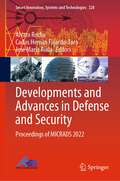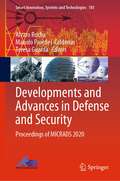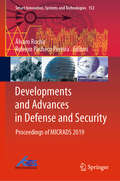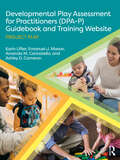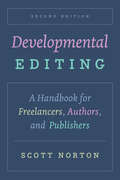- Table View
- List View
Dialects from Tropical Islands: Caribbean Spanish in the United States (Routledge Studies in Hispanic and Lusophone Linguistics)
by Wilfredo Valentín-Márquez Melvin González-Rivera Dale Koike Javier Muñoz-BasolsDialects from Tropical Islands: Caribbean Spanish in the United States provides a comprehensive account of current research on Caribbean Spanish in the United States from different theoretical perspectives and linguistic areas. This edited volume highlights current scholarship and linguistic analyses in four major areas relative to Caribbean Spanish in the United States: phonological and phonetic variation, morphosyntactic approaches, sociolinguistic perspectives, and heritage-language acquisition. This volume will be of interest to linguists and philologists who specialize in Spanish, Caribbean Spanish, Spanish in the United States, or in Romance languages in general.
Dialectical Approaches to Studying Personal Relationships
by Barbara M. Montgomery Leslie A. BaxterThis book describes many different and useful ways of understanding personal relationships from a dialectical perspective. It is written for scholars in higher education, both faculty and students, across many fields within the social sciences and the humanities who seek answers to questions about how people relate to one another. The book is valuable for all scholars who pursue new ideas because it models a form of scholarly communication in which: * multiple voices can be acknowledged as valid; * the worth of one perspective is not measured by the denigration of another; and * difference is celebrated as conducive to learning rather than threatening to it. The contributors emphasize the characteristics of their dialectical view that set them apart from other dialectical authors and describe their methods of studying relationships from a dialectical perspective. Following the Bakhtinian perspective, they honor the values of dialogism by respecting different and sometimes contradictory views, assuming that these views can be valid, and joining in a discussion with the editors and other contributors about their emerging work. They also acknowledge that the chapters in this text are part of an ongoing process to frame and reframe emerging ideas, and allow the dialogue that occurs within this frame the freedom to express creative, unique ideas.
Dialectical Approaches to Studying Personal Relationships
by Barbara M. Montgomery Leslie A. BaxterThis book describes many different and useful ways of understanding personal relationships from a dialectical perspective. It is written for scholars in higher education, both faculty and students, across many fields within the social sciences and the humanities who seek answers to questions about how people relate to one another. The book is valuable for all scholars who pursue new ideas because it models a form of scholarly communication in which: * multiple voices can be acknowledged as valid; * the worth of one perspective is not measured by the denigration of another; and * difference is celebrated as conducive to learning rather than threatening to it. The contributors emphasize the characteristics of their dialectical view that set them apart from other dialectical authors and describe their methods of studying relationships from a dialectical perspective. Following the Bakhtinian perspective, they honor the values of dialogism by respecting different and sometimes contradictory views, assuming that these views can be valid, and joining in a discussion with the editors and other contributors about their emerging work. They also acknowledge that the chapters in this text are part of an ongoing process to frame and reframe emerging ideas, and allow the dialogue that occurs within this frame the freedom to express creative, unique ideas.
Dialect, Voice, and Identity in Chinese Translation: A Descriptive Study of Chinese Translations of Huckleberry Finn, Tess, and Pygmalion (Routledge Studies in Chinese Translation)
by Jing YuDialect, Voice, and Identity in Chinese Translation is the first book-length attempt to undertake a descriptive investigation of how dialect in British and American novels and dramas is translated into Chinese. Dialect plays an essential role in creating a voice of difference for the regional, social, or ethnic Others in English fiction. Translating dialect involves not only the textual representation of a different voice with target linguistic resources, but also the reconstruction of various cultural, social, and ethnic identities and relations on the target side. This book provides a descriptive study of 277 Chinese translations published from 1931 to 2020 for three fictions – The Adventures of Huckleberry Finn, Tess of the d’Urbervilles, and Pygmalion – with a special focus on how the Dorset dialect, African American Vernacular English, and cockney in them have been translated in the past century in China. It provides a comprehensive description of the techniques, strategies, tendencies, norms, and universals as well as diachronic changes and stylistic evolutions of the language used in dialect translation into Chinese. An interdisciplinary perspective is adopted to conduct three case studies of each fiction to explore the negotiation, reformulation, and reconstruction via dialect translation of the identities for Others and Us and their relations in the Chinese context. This book is intended to act as a useful reference for scholars, teachers, translators, and graduate students from disciplines such as translation, sociolinguistics, literary and cultural studies, and anyone who shows interest in dialect translation, the translation of American and British literature, Chinese language and literature, identity studies, and cross-cultural studies.
Dialect, Voice, and Identity in Chinese Translation: A Descriptive Study of Chinese Translations of Huckleberry Finn, Tess, and Pygmalion (Routledge Studies in Chinese Translation)
by Jing YuDialect, Voice, and Identity in Chinese Translation is the first book-length attempt to undertake a descriptive investigation of how dialect in British and American novels and dramas is translated into Chinese. Dialect plays an essential role in creating a voice of difference for the regional, social, or ethnic Others in English fiction. Translating dialect involves not only the textual representation of a different voice with target linguistic resources, but also the reconstruction of various cultural, social, and ethnic identities and relations on the target side. This book provides a descriptive study of 277 Chinese translations published from 1931 to 2020 for three fictions – The Adventures of Huckleberry Finn, Tess of the d’Urbervilles, and Pygmalion – with a special focus on how the Dorset dialect, African American Vernacular English, and cockney in them have been translated in the past century in China. It provides a comprehensive description of the techniques, strategies, tendencies, norms, and universals as well as diachronic changes and stylistic evolutions of the language used in dialect translation into Chinese. An interdisciplinary perspective is adopted to conduct three case studies of each fiction to explore the negotiation, reformulation, and reconstruction via dialect translation of the identities for Others and Us and their relations in the Chinese context. This book is intended to act as a useful reference for scholars, teachers, translators, and graduate students from disciplines such as translation, sociolinguistics, literary and cultural studies, and anyone who shows interest in dialect translation, the translation of American and British literature, Chinese language and literature, identity studies, and cross-cultural studies.
Diagnosing and Treating Medicus Incomprehensibilis: Case Studies in Revising Medical Writing
by Oscar Linares David T. Daly Gertrude A. DalyDiagnosing and Treating Medicus Incomphensibilis is a book of case studies on revising medical writing into plain English. It is a companion to Plain English for Doctors and Other Medical Scientists (Oxford University Press, 2017). It gives more practice to help the reader master skills in plain English medical writing. The 12 case studies are based on excerpts from articles published in leading medical journals. The excerpts cover a wide range of medical topics. Each case study looks at one excerpt, between 56 and 308 words long, that shows many classic symptoms of medicus incomprehensibilis - those overused writing habits that make medical writing hard to read. The case study asks questions, and gives short exercises, to guide the reader through the process of diagnosing the symptoms of medicus incomprehensibilis. The reader writes their prescription and revises to treat the symptoms. After each case study, the authors give their answers, prescription and revision. This book is intended for doctors and other medical scientists who write for medical journals, and anyone who aspires to do so. It is intended for writers at all levels, from veteran authors to students. It includes writers in related fields such as public health, pharmacology, nursing and life sciences. It is designed for self-study, seminar or classroom use.
Diagnosing and Treating Medicus Incomprehensibilis: Case Studies in Revising Medical Writing
by Oscar Linares David T. Daly Gertrude A. DalyDiagnosing and Treating Medicus Incomphensibilis is a book of case studies on revising medical writing into plain English. It is a companion to Plain English for Doctors and Other Medical Scientists (Oxford University Press, 2017). It gives more practice to help the reader master skills in plain English medical writing. The 12 case studies are based on excerpts from articles published in leading medical journals. The excerpts cover a wide range of medical topics. Each case study looks at one excerpt, between 56 and 308 words long, that shows many classic symptoms of medicus incomprehensibilis - those overused writing habits that make medical writing hard to read. The case study asks questions, and gives short exercises, to guide the reader through the process of diagnosing the symptoms of medicus incomprehensibilis. The reader writes their prescription and revises to treat the symptoms. After each case study, the authors give their answers, prescription and revision. This book is intended for doctors and other medical scientists who write for medical journals, and anyone who aspires to do so. It is intended for writers at all levels, from veteran authors to students. It includes writers in related fields such as public health, pharmacology, nursing and life sciences. It is designed for self-study, seminar or classroom use.
Diagnosability, Security and Safety of Hybrid Dynamic and Cyber-Physical Systems
by Moamar Sayed-MouchawehCyber-physical systems (CPS) are characterized as a combination of physical (physical plant, process, network) and cyber (software, algorithm, computation) components whose operations are monitored, controlled, coordinated, and integrated by a computing and communicating core. The interaction between both physical and cyber components requires tools allowing analyzing and modeling both the discrete and continuous dynamics. Therefore, many CPS can be modeled as hybrid dynamic systems in order to take into account both discrete and continuous behaviors as well as the interactions between them. Guaranteeing the security and safety of CPS is a challenging task because of the inherent interconnected and heterogeneous combination of behaviors (cyber/physical, discrete/continuous) in these systems. This book presents recent and advanced approaches and tech-niques that address the complex problem of analyzing the diagnosability property of cyber physical systems and ensuring their security and safety against faults and attacks. The CPS are modeled as hybrid dynamic systems using different model-based and data-driven approaches in different application domains (electric transmission networks, wireless communication networks, intrusions in industrial control systems, intrusions in production systems, wind farms etc.). These approaches handle the problem of ensuring the security of CPS in presence of attacks and verifying their diagnosability in presence of different kinds of uncertainty (uncertainty related to the event occurrences, to their order of occurrence, to their value etc.).
DFT - Diskrete Fourier-Transformation: Elementare Einführung
by André NeubauerDie diskrete Fourier-Transformation DFT stellt eines der wichtigsten Werkzeuge der digitalen Signalverarbeitung und der Signaltheorie dar. Sie besitzt eine Vielzahl von Anwendungen wie beispielsweise in der Informations- und Kommunikationstechnik, in der technischen Informatik, in der Messtechnik und in der Medizintechnik. Das Lehrbuch bietet eine leicht verständliche elementare Einführung in die Grundlagen der DFT. Neben den Eigenschaften und Korrespondenzen der DFT werden ihre effiziente Implementierung mit Hilfe der schnellen Fourier-Transformation FFT erläutert sowie als wichtiges Anwendungsbeispiel die schnelle Faltung behandelt. Sämtliche im Buch für die Behandlung der DFT benötigten mathematischen Grundlagen werden beschrieben und erleichtern somit sowohl Studierenden als auch Schülern den Zugang zu diesem für praktische Anwendungen wichtigen und interessanten Themenfeld. Aufgrund der eingefügten Beispiele sowie der detaillierten Herleitungen ist das Buch sowohl vorlesungsbegleitend als auch zum Selbststudium hervorragend geeignet.
Dew Computing: The Sustainable IoT Perspectives (Internet of Things)
by Debashis De Samarjit RoyThis book discusses the dew computing paradigm with the evolution of future-generation technologies through the cloud and the Internet of Things in the scope of machine intelligence. Dew computing is an emerging paradigm that inherits a flexible and super-hybrid methodology to afford personal information to users with self-regulating internetwork connectivity. The contents conceptualize how the end-users can benefit from data analytics through intelligent data sensing, computing, analytics, and distributed scenarios using a dew-cloud computational framework over the Internet of Things environment. The main focus of this book is to bring all the related technologies into a single platform so that undergraduate and postgraduate students, researchers, academicians, and the industry can easily understand dew computing, future generations of cloud computing, machine intelligence, and representation learning in IoT-enabled technologies.
The Devil's Dictionary: Satirical Definitions of Everyday Words (G - Reference,information And Interdisciplinary Subjects Ser.)
by Ambrose Bierce"Politeness, n. The most acceptable hypocrisy."In this extraordinary work of scathing satire, Ambrose Bierce provided new humorous definitions of the words that formed the lexicon of contemporary American life.Accumulated over three decades for a series of magazines and newspapers, the entries in The Devil's Dictionary painted a revealing portrait of late 19th-century American life, with all its contradictions and hypocrisies laid bare.Bierce's fantastic wit and incredible gift for irony shine through this true masterpiece of American literature.
Device-to-Device Communications in Cellular Networks (SpringerBriefs in Electrical and Computer Engineering)
by Li Wang Huan TangThis SpringerBrief focuses on crucial issues for device-to-device (D2D) communications within the rapidly expanding 4G LTE toward 5G system. Several critical technical challenges in D2D communications are discussed, and D2D standardization activities in 3GPP are provided. Topics range from proximity discovery and mode selection, to resource management. The authors investigate proximity detection solutions for enabling direct user equipment communication by listening to uplink transmission. The problem of mixed mode selection is demonstrated to meet multiple quality of service (QoS) requirements in D2D enabled cellular networks. Finally, the brief explores the problem of designing interference-constrained resource allocation to pair cellular user resources with potential D2D links in cellular D2D underlay, with the goal of improving spectrum efficiency. Device-to-Device Communications in Cellular Networks targets researchers and professionals working in wireless communications and networks. Advanced-level students in electrical engineering and computer science studying wireless communications and networks can also use this material as a study guide.
Device-Free Object Tracking Using Passive Tags (SpringerBriefs in Electrical and Computer Engineering)
by Jinsong Han Wei Xi Kun Zhao Zhiping JiangThis SpringerBrief examines the use of cheap commercial passive RFID tags to achieve accurate device-free object-tracking. It presents a sensitive detector, named Twins, which uses a pair of adjacent passive tags to detect uncooperative targets (such as intruders). Twins leverages a newly observed phenomenon called critical state that is caused by interference among passive tags. The author expands on the previous object tracking methods, which are mostly device-based, and reveals a new interference model and their extensive experiments for validation. A prototype implementation of the Twins-based intrusion detection scheme with commercial off-the-shelf reader and tags is also covered in this SpringerBrief. Device-Free Object Tracking Using Passive Tags is designed for researchers and professionals interested in smart sensing, localization, RFID and Internet of Things applications. The content is also useful for advanced-level students studying electrical engineering and computer science.
Device-Edge-Cloud Continuum: Paradigms, Architectures and Applications (Internet of Things)
by Claudio Savaglio Giancarlo Fortino MengChu Zhou Jianhua MaThis book focuses on both theoretical and practical aspects of the “Device-Edge-Cloud continuum”, a development approach aimed at the seamless provision of next-generation cyber-physical services through the dynamic orchestration of heterogeneous computing resources, located at different distances to the user and featured by different peculiarities (high responsiveness, high computing power, etc.). The book specifically explores recent advances in paradigms, architectures, models, and applications for the “Device-Edge-Cloud continuum”, which raises many 'in-the-small' and 'in-the-large' issues involving device programming, system architectures and methods for the development of IoT ecosystem. In this direction, the contributions presented in the book propose original solutions and aim at relevant domains spanning from healthcare to industry, agriculture and transportation.
Developments in Cognitive Radio Networks: Future Directions for Beyond 5G
by Bodhaswar TJ Maharaj Babatunde Seun AwoyemiThis book provides holistic yet concise information on what modern cognitive radio networks are, how they work, and the possible future directions for them. The authors first present the most generic models of modern cognitive radio networks, taking into consideration their different architectural designs and classifications. While the spectrum resource is shown to be the most important resource for the cognitive radio networks, the book exposes the importance of the other resources that are needed to help drive the technology. The book then discusses in-depth the key tools (such as optimization and queuing theory) and techniques (such as cooperative diversity and relaying) that are being employed to formulate resource problems, investigate solutions, and interpret such solutions for useful and practical modern cognitive radio networks realization. Further, the book studies the impact of modern cognitive radio networks on other emerging technologies -- such as 5G, Internet of Things, and advanced wireless sensor networks -- and discusses the role that cognitive radio networks play in the evolution of smart cities and in the realization of a highly interconnected world. In discussing the future of the cognitive radio networks, the book emphasizes the need to advance new or improved tools, techniques, and solutions to address lingering problems in the aspects of resource realization and utilization, network complexity, network security, etc., which can potentially limit the cognitive radio networks in their stride to becoming one of the most promising technologies for the immediate and near future.
Developments and Advances in Defense and Security: Proceedings of MICRADS 2021 (Smart Innovation, Systems and Technologies #255)
by Álvaro Rocha Carlos Hernan Fajardo-Toro José María Riola RodríguezThis book gathers the proceedings of the Multidisciplinary International Conference of Research Applied to Defense and Security (MICRADS 2021), held at Naval Cadet School "Almirante Padilla", in Cartagena, Colombia, during August 18–20, 2021. It covers a broad range of topics in systems, communication, and defense; strategy and political–administrative vision in defense; and engineering and technologies applied to defense. Given its scope, it offers a valuable resource for practitioners, researchers, and students alike.
Developments and Advances in Defense and Security: MICRADS 2023 (Smart Innovation, Systems and Technologies #380)
by Álvaro Rocha Carlos Hernán Fajardo-Toro José María Riola RodríguezThis book gathers the proceedings of the Multidisciplinary International Conference of Research Applied to Defense and Security (MICRADS 2023), held at Graduate School of the Colombian Air Force, in Bogota, Colombia, during July 6–8, 2023. It covers a broad range of topics in systems, communication, and defense; strategy and political–administrative vision in defense; and engineering and technologies applied to defense. Given its scope, it offers a valuable resource for practitioners, researchers, and students alike.
Developments and Advances in Defense and Security: Proceedings of MICRADS 2022 (Smart Innovation, Systems and Technologies #328)
by Álvaro Rocha Carlos Hernan Fajardo-Toro José María RiolaThis book gathers the proceedings of the Multidisciplinary International Conference of Research Applied to Defense and Security (MICRADS 2022), held at Escuela Naval de Suboficiales ARC "Barranquilla," in Barranquilla, Colombia, during July 11–13, 2022. It covers a broad range of topics in systems, communication, and defense; strategy and political–administrative vision in defense; and engineering and technologies applied to defense. Given its scope, it offers a valuable resource for practitioners, researchers, and students alike.
Developments and Advances in Defense and Security: Proceedings of MICRADS 2020 (Smart Innovation, Systems and Technologies #181)
by Álvaro Rocha Teresa Guarda Manolo Paredes-CalderónThis book gathers the proceedings of the Multidisciplinary International Conference of Research Applied to Defense and Security (MICRADS), held at the Eloy Alfaro Military Academy (ESMIL) in Quito, Ecuador, on May 13–15,2020. It covers a broad range of topics in systems, communication, and defense; strategy and political–administrative vision in defense; and engineering and technologies applied to defense. Given its scope, it offers a valuable resource for practitioners, researchers, and students alike.
Developments and Advances in Defense and Security: Proceedings of MICRADS 2019 (Smart Innovation, Systems and Technologies #152)
by Álvaro Rocha Robson Pacheco PereiraThis book gathers the proceedings of the Multidisciplinary International Conference of Research Applied to Defense and Security (MICRADS), held at the Military Engineering Institute, Rio de Janeiro, Brazil, from 8 to 10th May 2019. It covers a variety of topics in systems, communication and defense; strategy and political-administrative vision in defense; and engineering and technologies applied to defense. Given its scope, it offers a valuable resource for practitioners, researchers, and students alike.
Developmental Play Assessment for Practitioners (DPA-P) Guidebook and Training Website: Project Play
by Karin Lifter Emanuel J. Mason Amanda M. Cannarella Ashley D. CameronDevelopmental Play Assessment for Practitioners (DPA-P) Guidebook and Training Website: Project Play offers a comprehensive assessment of naturally occurring play activities for evaluating young children’s developmental progress accurately, so that useful interventions can take place as early as possible. It can be used by practitioners in a wide range of educational and therapeutic settings and is designed to support developmental progress through planning interventions in play, and using what we know about a child’s progress in play to plan play-based interventions in cognition, language, motor, social-emotional, and self-help skills. The guidebook and training website provide a comprehensive introduction to how to successfully use the assessment with infants, toddlers, and young children with disabilities or at risk for disabilities. The comprehensive guidebook offers an overview of the DPA-P and Project Play, defines play, discusses the background literature on play, and explains why this assessment is needed. Clear guidance helps practitioners and family members understand play, how to evaluate play, and how to use play for different purposes. The guidebook offers: an introduction to the comprehensive training website and how to use it understanding of the categories of play assessed and their definitions guidance on how to administer the assessment and prepare a summary evaluation of a child’s performance clear instructions for the coding sheets and scoring guidelines for constructing sets of toys guidance on taking the results of the DPA-P evaluation of a child’s progress in play to develop a plan of activities for intervention explanation of how you evaluate activities at the absence, basic, emergence, and mastery levels for developing a plan suggestions for assembling sets of toys for intervention, based on toys available in children’s homes and early childhood settings procedures for facilitating or teaching play activities to children who are developing more slowly than their peers technical aspects of the assessment To make the DPA-P as flexible as possible for all practitioners, it also offers guidance on adaptations for administering the test, in the coding sheets, with toys to enhance cultural appropriateness for gathering the observations, and for supporting interventions in play. The Developmental Play Assessment for Practitioners (DPA-P) can be used in natural settings and takes 30 minutes to complete. It is a valuable tool for all those who serve, or are training to serve, young children in early childhood settings, schools, service agencies, colleges, and universities. It will be of great benefit for early intervention personnel, speech-language pathologists, physical therapists, occupational therapists, and psychologists.
Developmental Play Assessment for Practitioners (DPA-P) Guidebook and Training Website: Project Play
by Karin Lifter Emanuel J. Mason Amanda M. Cannarella Ashley D. CameronDevelopmental Play Assessment for Practitioners (DPA-P) Guidebook and Training Website: Project Play offers a comprehensive assessment of naturally occurring play activities for evaluating young children’s developmental progress accurately, so that useful interventions can take place as early as possible. It can be used by practitioners in a wide range of educational and therapeutic settings and is designed to support developmental progress through planning interventions in play, and using what we know about a child’s progress in play to plan play-based interventions in cognition, language, motor, social-emotional, and self-help skills. The guidebook and training website provide a comprehensive introduction to how to successfully use the assessment with infants, toddlers, and young children with disabilities or at risk for disabilities. The comprehensive guidebook offers an overview of the DPA-P and Project Play, defines play, discusses the background literature on play, and explains why this assessment is needed. Clear guidance helps practitioners and family members understand play, how to evaluate play, and how to use play for different purposes. The guidebook offers: an introduction to the comprehensive training website and how to use it understanding of the categories of play assessed and their definitions guidance on how to administer the assessment and prepare a summary evaluation of a child’s performance clear instructions for the coding sheets and scoring guidelines for constructing sets of toys guidance on taking the results of the DPA-P evaluation of a child’s progress in play to develop a plan of activities for intervention explanation of how you evaluate activities at the absence, basic, emergence, and mastery levels for developing a plan suggestions for assembling sets of toys for intervention, based on toys available in children’s homes and early childhood settings procedures for facilitating or teaching play activities to children who are developing more slowly than their peers technical aspects of the assessment To make the DPA-P as flexible as possible for all practitioners, it also offers guidance on adaptations for administering the test, in the coding sheets, with toys to enhance cultural appropriateness for gathering the observations, and for supporting interventions in play. The Developmental Play Assessment for Practitioners (DPA-P) can be used in natural settings and takes 30 minutes to complete. It is a valuable tool for all those who serve, or are training to serve, young children in early childhood settings, schools, service agencies, colleges, and universities. It will be of great benefit for early intervention personnel, speech-language pathologists, physical therapists, occupational therapists, and psychologists.
A Developmental-functionalist Approach To Child Language
by Nancy BudwigAlthough there has been much empirical study within what has been referred to as "functional approaches to child language," there has yet to be a major attempt to compare and contrast such proposals. In addition, much of the work carried out within child language from a functionalist perspective has not been specific with regard to the nature of the approach adopted. In attempting to fill the gap, the author of this book begins with a comparison of various functionalist approaches. By concentrating on one domain -- agentivity and control -- Budwig develops a set of research questions based on an examination of findings stemming from linguistics, psycholinguistics, and developmental psychology, and also provides an in-depth discussion of related methodological issues. In the second part of the book, she traces the development of linguistic means to refer to oneself within a developmental-functionalist perspective. Individual case studies as well as group analyses of six children in the early phases of acquiring English grammar are provided. In the last part, Budwig examines the relationship between forms and functions in development with special attention to potential generalizations about the organization and reorganization of the children's linguistic systems.
A Developmental-functionalist Approach To Child Language
by Nancy BudwigAlthough there has been much empirical study within what has been referred to as "functional approaches to child language," there has yet to be a major attempt to compare and contrast such proposals. In addition, much of the work carried out within child language from a functionalist perspective has not been specific with regard to the nature of the approach adopted. In attempting to fill the gap, the author of this book begins with a comparison of various functionalist approaches. By concentrating on one domain -- agentivity and control -- Budwig develops a set of research questions based on an examination of findings stemming from linguistics, psycholinguistics, and developmental psychology, and also provides an in-depth discussion of related methodological issues. In the second part of the book, she traces the development of linguistic means to refer to oneself within a developmental-functionalist perspective. Individual case studies as well as group analyses of six children in the early phases of acquiring English grammar are provided. In the last part, Budwig examines the relationship between forms and functions in development with special attention to potential generalizations about the organization and reorganization of the children's linguistic systems.
Developmental Editing, Second Edition: A Handbook for Freelancers, Authors, and Publishers (Chicago Guides to Writing, Editing, and Publishing)
by Scott NortonThe only guide dedicated solely to developmental editing, now revised and updated with new exercises and a chapter on fiction. Developmental editing—transforming a manuscript into a book that edifies, inspires, and sells—is a special skill, and Scott Norton is one of the best at it. With more than three decades of experience in the field, Norton offers his expert advice on how to approach the task of diagnosing and fixing structural problems with book manuscripts in consultation with authors and publishers. He illustrates these principles through a series of detailed case studies featuring before-and-after tables of contents, samples of edited text, and other materials to make an otherwise invisible process tangible. This revised edition for the first time includes exercises that allow readers to edit sample materials and compare their work with that of an experienced professional as well as a new chapter on the unique challenges of editing fiction. In addition, it features expanded coverage of freelance business arrangements, self-published authors, e-books, content marketing, and more. Whether you are an aspiring or experienced developmental editor or an author who works alongside one, you will benefit from Norton’s accessible, collaborative, and realistic approach and guidance. This handbook offers the concrete and essential tools it takes to help books to find their voice and their audience.

